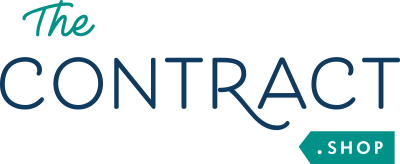Your Cart is Empty
Shop confidently - 14-day no-hassle return policy
Shop confidently - 14-day no-hassle return policy
Shop confidently - 14-day no-hassle return policy
What’s the first thing you think about doing when launching a new business?
Most new entrepreneurs start by thinking about their branding… Picking signature colors. Coming up with a super awesome logo. Obsessing over the perfect business name and tagline.
Ohhhhh yeah… #bringonthecolors
The problem is, sure, all those things are important – but in the grand scheme of things, it’s the non-visual stuff that reallymakes your business stand out.
The reallyimportant parts of branding are the non-visual bits… elements like:
For example, I’ve built The Contract Shop® around the idea that I educate creative entrepreneurs about the legal aspects of business and providing them with affordable solutions… but in a fun, easy-to-understand way, without all the legal mumbo-jumbo that you’re likely to run into elsewhere.
If you sign up for a webinar with me, are you going to find yourself in a “Understanding Legal Contracts 101” course, with an exam at the end? No!
I went to school so that you don’t have to, and I use my legal education to help creative business owners who have better things to do than sit around worrying about whether they have the right contracts and copyright protection in place.
So if I started publishing blog content that read like my old lawschool textbooks, wouldn’t you think I’d gone a bit wacko and start looking elsewhere for help?
I bet you would, and I wouldn’t blame you, because I’d be acting inconsistently with everything I’ve done before.
Your personal brand is a combination of the way you see yourself and your business and how others (ie: your clients) see you.
To help you visualize this, grab a sheet of paper and draw two big circles, one on either end of the page, with the centers overlapping. Voila! You’ve just made a Venn diagram! (Remember those from grade school?)
In one circle, write down what you think about when it comes to your business… your brand’s (or your) personality, values, mission, and anything else you can think of that you want your clients to know about you.
In the other circle, write down all the things your clients think about you or your business… terms that describe how they perceive your brand, their experience, and the outcome of their work with you.
Now, in the middle (where the circles overlap) is the sweet spot between what you’re trying to convey and what your customers actually think about you and your business. That’s what your personal brand message is right now.
Once you’ve made that discovery, you can decide whether your clients’ perceptions are accurate or whether you need to put in a little more work to accurately portray what you and your business actually stand for.
If you’re having trouble with the Venn diagram exercise, the problem might not be not knowing your values. Instead, it might be not really knowing what you want to offer.
Lemme tell you… when I first graduated from law school, I was All. Over. The. Place.
First I decided to be a graphic designer and calligraphy artist. Then floral design looked cool, so I picked up training on how to do that. I also loved photography, so I added wedding photography to my services. And when none of those careers seemed to be quite the right fit, I decided to become a personal yoga trainer!
Is it any wonder that my potential clients were confused? Who was this girl, and what was she doing, anyway?!
If this is you too, don’t fret about it. We all have to start somewhere. But at some point, you’ll need to take the old adage “niche down” to heart.
As you’re going through these exercises, remember to consider how your service will affect your client’s lives and what kind of results they’ll get from working with you. This will help you drill down to find the brand values you really want to be known for.
Now that you’ve identified your personal branding values, your services, and who you want to help, you can put it all together in a simple elevator pitch that covers the who, what, why of your business!
My name is ___________ and I am a _______________ who offers ___________, __________, & ___________ to my clients to help them ___________.
Final note: The process of personal branding means that you become more attractive to your ideal clients… but at the same time, it means that you’ll seem less attractive to other “potential” clients. Remember that this is not a bad thing! Any “potential” clients who don’t care for your quirky personality or your business values aren’t going to be a good fit for you in the first place… so concentrate on being your own fabulous self, and attracting the people you’ll work best with!
Wanna join up with other fab business owners get more tips and tools for growing your business? Join me over in the Law Law Land Facebook group!
Click here to download the FREE ultimate legit + profitable business guide TODAY!

Comments will be approved before showing up.
